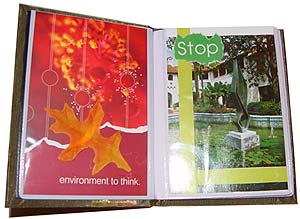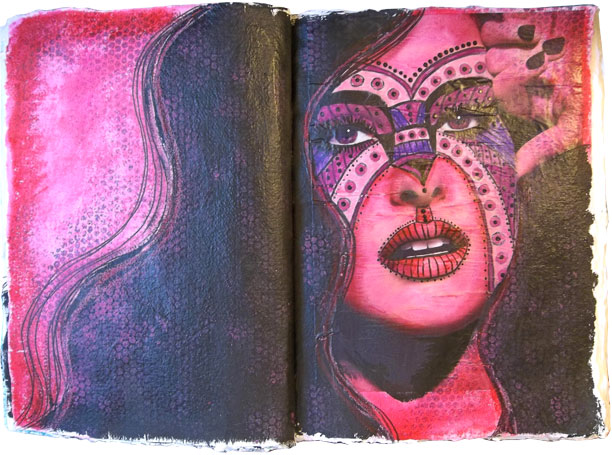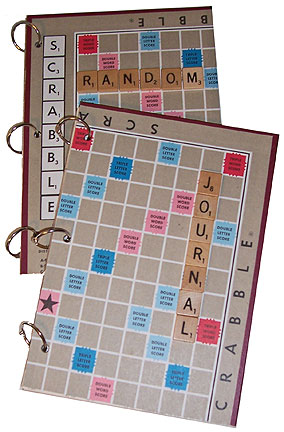 I decided to turn a Scrabble board into a pair of simple journals, to hold random pieces of artwork, and perhaps my next gluebook page-a-day project. Although I often use composition books or old novels for my gluebooks, I do generally run out of steam before I run out of pages to fill. I find I prefer to work flat, outside a book, and then add the page in later. These little journals, joined with binder rings from the office supply store, are ideal for that type of work.
I decided to turn a Scrabble board into a pair of simple journals, to hold random pieces of artwork, and perhaps my next gluebook page-a-day project. Although I often use composition books or old novels for my gluebooks, I do generally run out of steam before I run out of pages to fill. I find I prefer to work flat, outside a book, and then add the page in later. These little journals, joined with binder rings from the office supply store, are ideal for that type of work.
 I started by splitting the Scrabble board in half on the fold, using a craft knife and a ruler with a metal edge.
I started by splitting the Scrabble board in half on the fold, using a craft knife and a ruler with a metal edge.
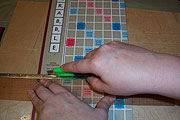 Next, I cut the board pieces to the size I desired for my journals. I wanted to keep them smaller than a standard sheet of paper, to use up some of the book pages and papers I had on hand, so I settled on 7 x 10 inches. I have my eye open for some larger papers and recycled pieces, so I can leave the boards full height next time, and make some tall journals.
Next, I cut the board pieces to the size I desired for my journals. I wanted to keep them smaller than a standard sheet of paper, to use up some of the book pages and papers I had on hand, so I settled on 7 x 10 inches. I have my eye open for some larger papers and recycled pieces, so I can leave the boards full height next time, and make some tall journals.
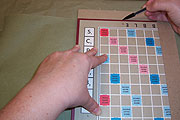 I had to decide what to do about the back of the journals. I could have simply used one board to create both the front and back. I also could have used the heavy board from the game’s box for a backing, saving the Scrabble boards with their fun graphics for the front covers. I have an abundance of chipboard sheets, so that’s what I used for backs. I figured I could always decorate or cover it later if the industrial look bothered me—but I think it probably won’t.
I had to decide what to do about the back of the journals. I could have simply used one board to create both the front and back. I also could have used the heavy board from the game’s box for a backing, saving the Scrabble boards with their fun graphics for the front covers. I have an abundance of chipboard sheets, so that’s what I used for backs. I figured I could always decorate or cover it later if the industrial look bothered me—but I think it probably won’t.
I simply traced around the outside of the front covers, and cut the chipboard with a craft knife.
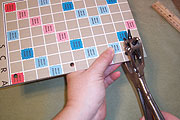 I measured and marked the placement of three holes. I use a wood ruler that’s pre-punched to tuck into a three-ring binder for this sort of thing—the spacing of the holes from either end of the ruler, and from the side edge usually work for anything of similar size. Once the two end holes are marked, I can simply measure the distance between them, and place the center hole on that mark.
I measured and marked the placement of three holes. I use a wood ruler that’s pre-punched to tuck into a three-ring binder for this sort of thing—the spacing of the holes from either end of the ruler, and from the side edge usually work for anything of similar size. Once the two end holes are marked, I can simply measure the distance between them, and place the center hole on that mark.
The holes were punched with a heavy metal punch, because for the life of me, I cannot find my screw punch.
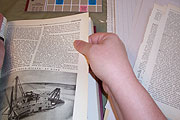 For pages, I fished through my paper stash, and pulled out half a dozen sheets of anything I had a lot of. I buy pads of newsprint, construction paper, penmanship practice paper, and whatever else I can find at the dollar stores just for this type of book. I also save any pages I cut or tear from altered books when I’m preparing them. Recycled papers, paper bags, envelopes—anything can go into these journals. Don’t feel all your pages ahve to be exactly the same size as the covers, either.
For pages, I fished through my paper stash, and pulled out half a dozen sheets of anything I had a lot of. I buy pads of newsprint, construction paper, penmanship practice paper, and whatever else I can find at the dollar stores just for this type of book. I also save any pages I cut or tear from altered books when I’m preparing them. Recycled papers, paper bags, envelopes—anything can go into these journals. Don’t feel all your pages ahve to be exactly the same size as the covers, either.
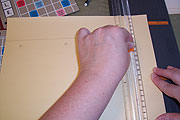 Those sheets that were oversized were trimmed down with a paper trimmer. When all the pages were ready, I punched holes in them, using the front cover as a guide.
Those sheets that were oversized were trimmed down with a paper trimmer. When all the pages were ready, I punched holes in them, using the front cover as a guide.
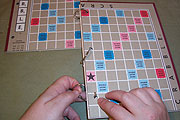 Three binder rings hold the journals together. I can always add or remove pages later, or mix pages around. I usually just tuck twenty or so sheets into blank books, to use as guides for cutting later, as dividers, as backgrounds for artwork, or to make notes.
Three binder rings hold the journals together. I can always add or remove pages later, or mix pages around. I usually just tuck twenty or so sheets into blank books, to use as guides for cutting later, as dividers, as backgrounds for artwork, or to make notes.
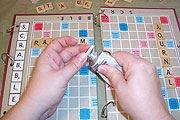 Just for fun, I used some of the Scrabble letters to label the journals, gluing them in place with E6000.
Just for fun, I used some of the Scrabble letters to label the journals, gluing them in place with E6000.
There you have it! I tucked these into the drawer of my coffee table, along with a gluestick and a pair of scissors. Next time I’m sitting in front of the television, I’ll be all set to play.


